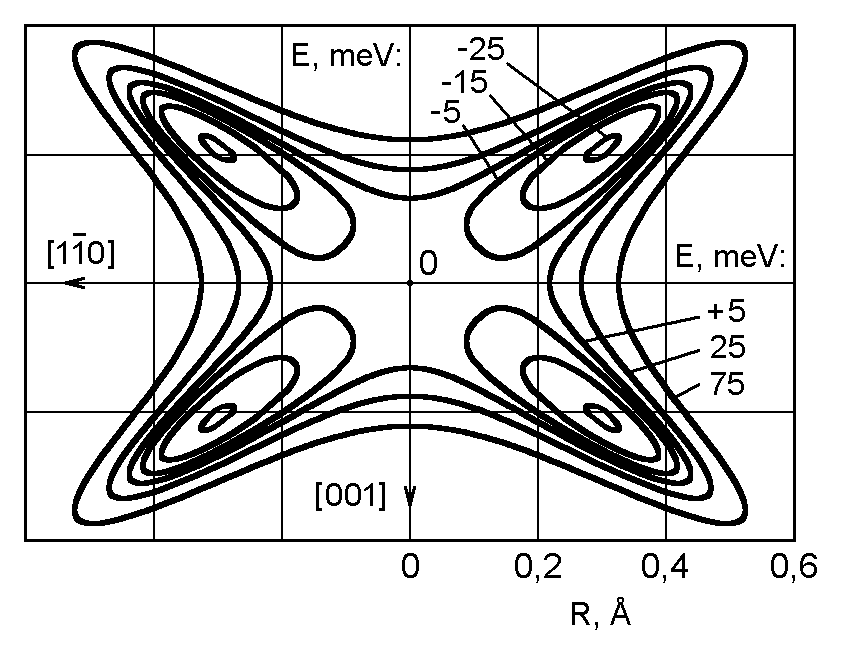This work was presented at the 7th Russia/CIS/Baltic/Japan Symposium on
Ferroelectricity (St. Petersburg, June 2002). Abstract book, p. 29.
Direct determination of the shape of potential well for off-center
Ge atom in GeTe-SnTe solid solution by EXAFS technique
A.I. Lebedev and
I.A. Sluchinskaya
Physics Department, Moscow State University, 119899, Moscow, Russia
The question whether the ferroelectric phase transition in GeTe and its solid
solutions is of displacive or order-disorder type has been open for many years.
Some experimental data (like heat capacity measurements [1]) indicated the
displacive type of the phase transition while the EXAFS data [2] showed that
Ge atoms are off-center in both GeTe-PbTe and GeTe-SnTe solid solutions.
In the present work we used the EXAFS technique to determine the shape of
potential well for the Ge atom in a series of Sn1-xGexTe
solid solution (x=0.2--1). Previously we have already used EXAFS to study
the microscopic mechanisms of the influence of impurities on the ferroelectric
phase transition in GeTe [3].
EXAFS data were collected at the synchrotron radiation source of Daresbury
Laboratory (UK) for four compositions of the solid solution in the temperature
range 80--300 K. The potential energy V(r) was expanded in a power series of
atomic displacement up to the 6th order. Supposing that the movement of the
Ge atom is classical, the parameterized expression for V was put into the
general formulae for EXAFS function \chi(k). As the resulting expression was
too complex and it was hard to treat it within the cumulant method, we
developed a method to solve the entire 3-dimensional problem. The expansion
coefficients for V(r) were then obtained by minimizing the deviation between
experimentally and calculated \chi(k) functions.
 The section of the potential energy surface in the direction perpendicular
to the [110] axis for Sn0.3Ge0.7Te sample is shown in
Figure. The potential wells are not very deep; their depth varies from
W=10 meV for x=0.2 to 30 meV for x=1. It is seen that for all samples
W is about a half of kTc. It is interesting that the potential
well is nearly the same for compositions above and below the tricritical
point (observed in Sn1-xGexTe at x=0.28 [4]), so
that the change of the order of the phase transition cannot be attributed
to a change of the shape of potential well. In summary, the results of
determination of the shape of potential well indicates that the type of
the phase transition in Sn1-xGexTe is intermediate
between the order-disorder and displacive ones.
The section of the potential energy surface in the direction perpendicular
to the [110] axis for Sn0.3Ge0.7Te sample is shown in
Figure. The potential wells are not very deep; their depth varies from
W=10 meV for x=0.2 to 30 meV for x=1. It is seen that for all samples
W is about a half of kTc. It is interesting that the potential
well is nearly the same for compositions above and below the tricritical
point (observed in Sn1-xGexTe at x=0.28 [4]), so
that the change of the order of the phase transition cannot be attributed
to a change of the shape of potential well. In summary, the results of
determination of the shape of potential well indicates that the type of
the phase transition in Sn1-xGexTe is intermediate
between the order-disorder and displacive ones.
[1] I. Hatta and W. Rehwald, J. Phys. C, 10, 2075 (1977).
[2] B.A. Bunker, Q.T. Islam, and W.-F. Pong, Physica, 158, 578 (1989).
[3] A.I. Lebedev, I.A. Sluchinskaya, V.N. Demin, and I.H. Munro,
Phase Transitions, 60, 67 (1997);
Phys.Rev.B, 55, 14770 (1997).
[4] R. Clarke, Phys.Rev.B, 18, 4920 (1978).
Other works on XAFS studies
Other works on off-center impurities
 The section of the potential energy surface in the direction perpendicular
to the [110] axis for Sn0.3Ge0.7Te sample is shown in
Figure. The potential wells are not very deep; their depth varies from
W=10 meV for x=0.2 to 30 meV for x=1. It is seen that for all samples
W is about a half of kTc. It is interesting that the potential
well is nearly the same for compositions above and below the tricritical
point (observed in Sn1-xGexTe at x=0.28 [4]), so
that the change of the order of the phase transition cannot be attributed
to a change of the shape of potential well. In summary, the results of
determination of the shape of potential well indicates that the type of
the phase transition in Sn1-xGexTe is intermediate
between the order-disorder and displacive ones.
The section of the potential energy surface in the direction perpendicular
to the [110] axis for Sn0.3Ge0.7Te sample is shown in
Figure. The potential wells are not very deep; their depth varies from
W=10 meV for x=0.2 to 30 meV for x=1. It is seen that for all samples
W is about a half of kTc. It is interesting that the potential
well is nearly the same for compositions above and below the tricritical
point (observed in Sn1-xGexTe at x=0.28 [4]), so
that the change of the order of the phase transition cannot be attributed
to a change of the shape of potential well. In summary, the results of
determination of the shape of potential well indicates that the type of
the phase transition in Sn1-xGexTe is intermediate
between the order-disorder and displacive ones.